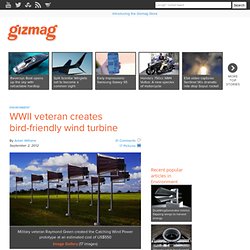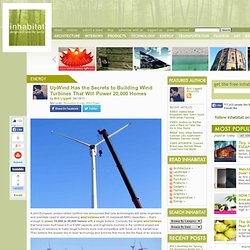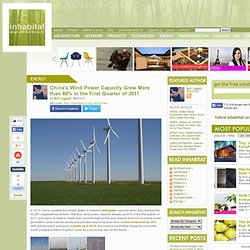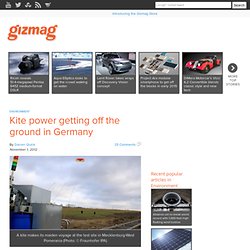

First Wind Power-Storing Coal Mines. It’s a classic story line in sustainability: dirty tech goes green.

We’ve seen coal mines transformed into geothermal energy stores and dirty plants become gorgeous green buildings. Now, for the first time ever, we may see out-of-use coal mines used as pump storage for wind power in Germany. Dabiri.caltech.edu/publications/WhLiDa_BB10.pdf. Honeywell Home Wind Turbine. The Honeywell wind turbine, a small lightweight gearless system built perfect for homes and small businesses, goes on sale today around the world!

The Honeywell, which was designed by WindTronics, measures six feet in diameter and is less than 185 pounds, and depending on where it is mounted, it can generate 1500kWh annually. But most impressively, the turbine is able to generate power for your home in wind as light as 2 miles per hour! The Honeywell goes on sale through authorized distributers around the world today — stores like Ace Hardware and True Value will be selling it — and it retails for $5,795 plus installation. Vertical Axis Wind Turbine.
EWICON bladeless wind turbine generates electricity using charged water droplets. Dutch researchers have developed the EWICON, a bladeless windmill with no moving parts that produces electricity by pushing charged water droplets into the wind Image Gallery (2 images) Wind energy may be one of the more sustainable sources of power available, but the spinning blades of conventional wind turbines require regular maintenance and have attracted criticism from bird lovers.

That might explain why we've seen wind turbine prototypes that enclose the blades in a chamber or replace them entirely with a disc-like system. But researchers in the Netherlands set out to eliminate the need for a mechanical component entirely and created the EWICON, a bladeless wind turbine with no moving parts that produces electricity using charged water droplets. Drive Your Wind Turbine To Work. The Aiolos Concept from designer Kyoung Soo Na is a proposed solution to the air pollution of South Korea.

In the Aiolos, you can drive to work in a wind turbine, which generates more energy the faster you drive, and then plug in to your office’s wind-powered energy grid to power up. Unlike some fan-powered cars that place a propeller under the vehicle at odd angles, this looks like it could actually work. There isn’t much room for carpooling in the Aiolos, though. It’s a one-seater that is purpose-built for commuting. Energy - China beats the US in wind energy. WWII veteran creates bird-friendly wind turbine. Military veteran Raymond Green created the Catching Wind Power prototype at an estimated cost of US$550 Image Gallery (17 images) World War II veteran Raymond Green, an 89 year old resident of Jackson, California, has created a working prototype of a "bladeless" wind turbine which is bird and bat-friendly, and very quiet in operation.

Though still in development at present, Green intends his design to be produced in various sizes, from smaller personal versions to much larger turbines which could be implemented in wind farms. View all. UpWind Wind Turbines. A joint European project called UpWind has announced that new technologies will allow engineers and scientists need to start producing wind turbines with 20 megawatt (MW) capacities — that’s enough to power 16,000 to 20,000 homes with a single turbine.

Currently the largest wind turbines that have been built have a 5 or 6 MW capacity, and engineers involved in the UpWind project are working on solutions to make larger turbines more cost competitive with those on the market now. They believe the answer lies in laser technology and turbines that move like the flaps of an airplane. Up until recently it was thought that 20 MW wind turbines were physically and economically impossible to build. The European Union wanted to know if that was truly the case, so they gave $33 million to a team led by the Risø National Laboratory for Sustainable Energy at the Technical University of Denmark (Risø DTU).
Via Science Daily. Wind and Water Power Program: Wind Powering America. The Sky Is the Limit for Wind Power. Wind turbines on land and offshore could readily provide more than four times the power that the world as a whole currently uses.

Throw in kites or robot aircraft generating electricity from sky-high winds and the world could physically extract roughly 100 times more power than presently employed—and the climatic consequences remain minimal. Two new computer-model analyses suggest there are few limits to the wind's potential. Although "there are physical limits to the amount of power that can be harvested from winds, these limits are well above total global energy demand," explains climate-modeler Kate Marvel of Lawrence Livermore National Laboratory, who led the analysis published September 9 in Nature Climate Change. (Scientific American is part of Nature Publishing Group.) Current global demand is roughly 18 terawatts. China's Capacity Grew > 60% 1st Quarter of 2011.
In 2010, China overtook the United States in installed wind power capacity when they reached the 42,287 megawatt benchmark.

With their wind power capacity already up 60% in the first quarter of 2011, and plans on track to install even more throughout the year, experts think China’s wind power generation could expand rapidly and perhaps help bring down their carbon emissions by 30%. With global carbon emissions actually up in 2010, this boost in renewable energy for one of the world’s largest emittors of carbon could be a promising sign for the future. Though China’s installed capacity is higher than any other country in the world their per capita wind power capacity and per GDP wind power capacity still pale in comparison to the world leader in both those categories, Denmark.
The Danes are crushing us all with their amazing 680.3 MW of capacity per million people — China has 33.6 MW per million people and the US has 129.6 MW per million. Via Clean Technica. Wind farms could provide windfall for local communities. Communities with windfarms in their area could get money off their electricity bills or grants for facilities such as playgrounds, the government has suggested.

The Department of Energy and Climate Change has launched a consultation into how communities could benefit from having windfarms sited near them, for example by receiving discounts on bills or investment in local infrastructure. It will also look at how local businesses could become involved in the supply chain and how developers can best consult local people. The energy secretary, Edward Davey, said that too often host communities had seen the "windfarm but not the windfall" and he wanted to ensure people benefited from them. Kite power getting off the ground in Germany. Despite offering numerous advantages over its rotating brethren, most notably the ability to reach the high-speed winds found at higher altitudes, kite-based energy systems are yet to really get off the ground in a meaningful way.

But things are looking up. Earlier this year, NASA revealed it is investigating ways to improve the aerodynamics and autonomous flight control of kites for power generation applications, and now Berlin-based wind energy developer NTS GmbH has teamed with the Fraunhofer Institute for Manufacturing Engineering and Automation (IPA) to make their own kite energy system concept a reality.
The team’s “kite power station” would see kites attached to cables measuring around 700 meters (2,297 ft) long, which would allow the kites to fly at heights of 300 to 500 meters (984 to 1,640 ft). “The energy yield of a kite far exceeds that of a wind turbine, whose rotor tips turn at a maximum height of 200 meters.
Source: Fraunhofer. Wind Lens floating farms. Windfarms break energy record in Spain. Spanish windfarms produced more electricity than any other source in the last three months. Photograph: Marco Cristofori/zefa/Corbis. Saphonian bladeless turbine boasts impressive efficiency, low cost. The Saphonian bladeless wind turbine draws inspiration from the design of a ship's sails Image Gallery (2 images) Wind Vibrations Turned into Electricity. Community Wind Across America.
Wind Power Generators. Annual Output (KWH/year) = 0.01328 (D^2) (V^3) source... Where D^2 is the blade diameter in feet squared, and V^3 is the wind velocity cubed in mph -- this is the year round average wind speed -- see wind maps below. So, a 10 ft diameter wind turbine in 12 mph average winds might produce about (0.01328)(10^2)(12^3) = 2300 KWH/year. Wind Power Breaks Records in Spain. Clean Power Published on February 6th, 2013 | by Zachary Shahan Denmark, the US, and Germany aren’t the only countries breaking wind power records these days. Spain is also a notable leader seeing strong wind power growth. In fact, it just saw its wind farms produce more electricity than any other source for a 3-month time period, for the first time ever.
“Since Nov. 1, wind has been the top technology in the electrical system,” the Spanish Wind Energy Association (SWEA) was quoted as writing on its blog. Additionally, data from grid operator Red Electrica de Espana concluded that 6 terawatt-hours (TWh) of electricity had been generated from wind in January, another first for the country. In total, SWEA noted that 6 TWh of electricity was enough to power “enough to cover the electricity consumption of the majority of Spanish households” and that it “could cover the annual electricity consumption of countries like Honduras and Bolivia.”
Wind powering america 2010 report. National Grid report challenges wind energy critics. Squirreled away beneath a recent Telegraph report on the subtleties of badger-culling in the UK was this intriguing morsel of wind energy news, which would seem to challenge the idea that intermittent energy sources such as wind play havoc with grid management. For the 23,700 gigawatt-hours of electrical energy generated by wind in the UK between April 2011 and September 2012, only 22 GWh of electrical energy from fossil fuels "was needed to fill the gaps when the wind didn't blow," it reports.
Gizmag contacted the UK National Grid to find out the details. The Telegraph's figures come from National Grid Head of Energy Strategy and Policy, Richard Smith, speaking at the Hay Festival between May 23 and Jun 2. Gizmag has learned that he was drawing from a National Grid document sent to the Scottish Parliament in response to its own report of Nov 23 2012, entitled Report on the achievability of the Scottish Government's renewable energy targets. Typical Wind Farm Supports Nearly 1,100 Jobs. NRDC REPORTS: Typical Wind Farm Supports Nearly 1,100 Jobs; Adds Millions of Dollars to Local Communities Congressional Inaction on Production Tax Credit Threatens to Stop Major Boost for Employment WASHINGTON (September 11, 2012) – Each major wind farm in America creates nearly 1,100 jobs and can add tens of millions of dollars in new taxes and other benefits to the communities where they’re located, according to two new reports from the Natural Resources Defense Council.
New Bladeless Wind Turbine Twice as Efficient? © Saphon When it comes to the future of wind power, one company thinks it looks a lot different than you would expect, and cheaper and more efficient to boot. Saphon, out of Tunisia, is interested in finding partners to mass-produce and market their unique wind energy device, based on their own Zero Blade technology. Saphonian bladeless turbine. Wind Map. An invisible, ancient source of energy surrounds us—energy that powered the first explorations of the world, and that may be a key to the future.
Wind Turbine Output Boosted 30% by Breakthrough Design. Strawscraper concept calls for a wind energy-harvesting toupee. Wind Power Innovations. Apple Designs a Wind Energy Storage Concept. Clean Power Published on January 5th, 2013 | by Nicholas Brown Apple Inc, the well-known manufacturer of phones, desktop, laptop, and tablet computers, has reportedly designed a unique energy storage system for wind energy. Apple energy storage concept. (Credit: U.S Patent and Trademark Office) It has been looking for ways to power its data center, and it realizes the benefits of wind power, such as zero fuel requirements, the opportunity to support the US economy more by buying US-built turbines, zero pollutant and greenhouse gas emissions, and a cost of 9.7 cents per kWh without government subsidies. 9.7 cents is a low cost; however, the implementation of energy storage increases it, and Apple will need energy storage or backup generators to compensate for power fluctuations, if they are to directly power their data center with it.
Apple’s Concept “Once sufficient heat is transferred to working fluid, the heat may be used to generate electricity. London Array - Harnessing the power of offshore wind. Schools of Fish Inspire New Wind Farms. Every now and then you come across an article and concept that makes you really smile and feel good on the inside. Typically they are "feel-good" stories that you see online or on the news, but today I came across this story about how scientists have designed new wind farms based on how schools of fish swim. So not only are we creating technology to help the environment but we are looking at nature for help. Wind Power Without the Blades. Wind power could drive the world. As the world seeks to lessen its reliance on fossil fuels like coal and natural gas, renewable energy sources like wind and solar power are being developed as alternatives.
Contrary to some other recent studies, analysis of climate data in the Proceedings of the National Academy of Sciences indicates wind turbines could harness hundreds of terawatts of electricity, far more than is needed to power the globe, even when accounting for the interplay between the groupings of turbines in so-called “wind farms.”
To reach that maximum potential, according to study author Mark Jacobson, it would require 1.5 billion massive windmills to be installed on and offshore. That’s far more than you would need to meet the world’s actual energy demands, the Stanford University engineer qualified, but you would still need many millions more turbines than currently exist. Jacobson envisions a very different future. Airborne Wind Turbine By Altaeros Energies. A floating wind turbine concept designed by Altaeros Energies is actually a hybrid of traditional windmill and a blimp. This clean energy alternative for remote villages and military sites will utilize strong high-altitude winds.
Japanese breakthrough. Vertical Shaft Axis. Dubai building with wind turbines. The sickening truth about wind farm syndrome. S.Africa unveils wind atlas in renewable energy push. I've Got the Power. Kites. INVELOX 600% more power. WindTamer Turbines - The Most Efficient Technology. The UK's Offshore Turbines Could Run Out of Wind. Wind Power Without the Blades. Output Boosted 30% by Breakthrough Design.